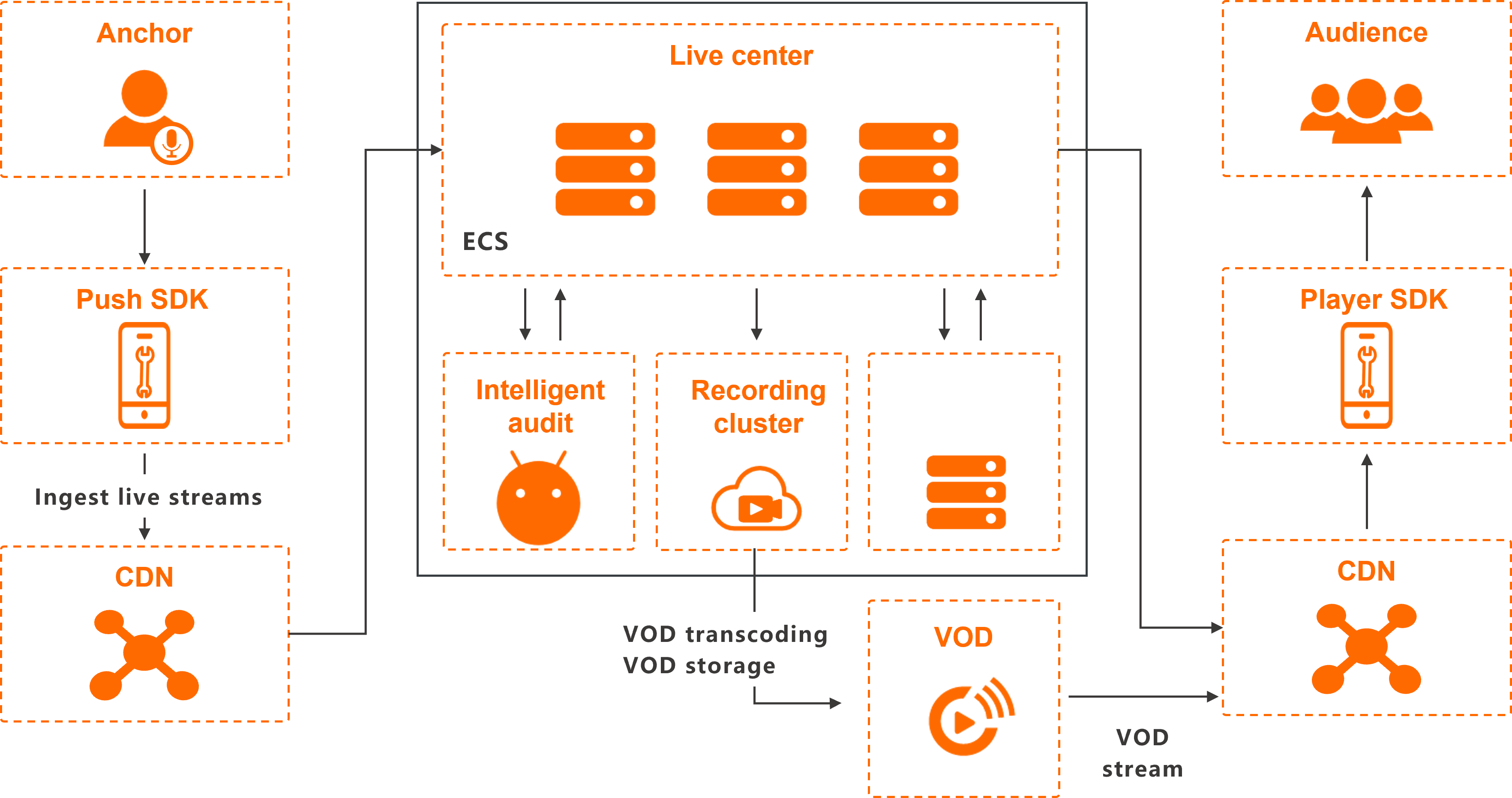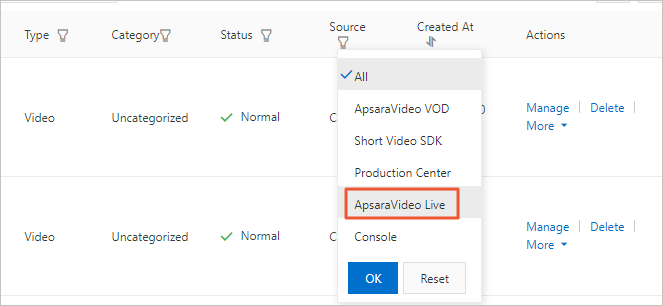ApsaraVideo VOD provides the live-to-VOD feature for you to synchronously record live streams as on-demand videos. Then, you can perform AI operations such as transcoding, content moderation, and intelligent thumbnail generation on videos. You can also produce video content by using the online editing feature, and accelerate content distribution by using Alibaba Cloud CDN. You can configure live-to-VOD as an automatic workflow in the ApsaraVideo VOD or ApsaraVideo Live console or flexibly start live-to-VOD processing by using the API or SDK. This topic describes the architecture and benefits of the live-to-VOD feature and how to use the feature.
Overall architecture
The following figure shows the overall architecture of the live-to-VOD feature.
Benefits
Compared with storing recorded videos in Object Storage Service (OSS), storing recorded videos in ApsaraVideo VOD has the following benefits:
One-stop video production: ApsaraVideo VOD supports automatic transcoding and CDN-based content delivery for recorded videos to implement one-stop video production.
Various media asset management capabilities: ApsaraVideo VOD provides various media asset management capabilities that you can use to manage recorded videos.
Powerful content production capabilities: You can directly edit recorded videos online by using the online editing service of ApsaraVideo VOD, which eliminates the need for traditional production processes.
Media processing capabilities such as automated review and AI: Based on powerful AI capabilities, ApsaraVideo VOD can perform operations such as automated review, intelligent thumbnail generation, and media fingerprinting on recorded videos.
Use live-to-VOD
Preparations
ApsaraVideo VOD is activated. For more information, see Activate ApsaraVideo VOD.
ApsaraVideo Live is activated. For more information, see Activate ApsaraVideo Live and purchase resource plans.
To store recordings in ApsaraVideo VOD, the region in which ApsaraVideo VOD is activated must be the same as the region in which the live center of the streaming domain resides.
Store live streams to ApsaraVideo VOD
Perform the following operations to record and store live streams to ApsaraVideo VOD.
Create a transcoding template group in ApsaraVideo VOD and configure video processing operations for recorded content.
Log on to the ApsaraVideo VOD console. On the Transcoding Template Group page, create a transcoding template group. For more information, see Overview.
Configure the settings for storing live streams to ApsaraVideo VOD in the ApsaraVideo Live console.
Log on to the ApsaraVideo Live console. In the left-side navigation pane, choose . Find the target streaming domain and click Domain Settings in the Actions column. On the page that appears, choose Templates. On the VOD tab in the Recording section, add a storage location. For more information, see Store recordings in ApsaraVideo VOD. You can also add recording configurations by calling the AddLiveRecordVodConfig operation.
After you perform the preceding preparations, you can use the live-to-VOD feature.
NoteWhen a stream is interrupted, the system waits three minutes before it stops recording the stream. This prevents unexpected truncation of recorded videos caused by network jitter or temporary stream interruptions. If a stream is re-ingested within three minutes after interruption, the system considers the new stream as the original stream. If a stream is re-ingested more than three minutes after interruption, the system considers the new stream as a different stream.
Query recorded videos
After live streams are recorded as on-demand videos, ApsaraVideo VOD provides various media asset management capabilities that you can use to manage recorded videos. You can obtain the recorded videos by using one of the following methods:
View recorded videos in the console
Log on to the ApsaraVideo VOD console. In the left-side navigation pane, choose Media Files > Audio/Video. On the Audio/Video page, select ApsaraVideo Live from the Source drop-down list.

Log on to the ApsaraVideo Live console. In the left-side navigation pane, choose Feature Management > Recording. On the Recording page, click the Recordings tab and query recorded videos based on Application Name and Stream Name.

Configure recording callbacks
Configure the AddLiveRecordVideoComplete event notification in ApsaraVideo VOD to obtain the recorded videos.
Call API operations
Call the ListLiveRecordVideo operation and specify the DomainName,
AppNameandStreamNameparameters to query videos.
References
Live to VOD: describes several use scenarios of the live-to-VOD feature. For example, how to use the live-to-VOD feature to record live streams, enable automatic transcoding for the video, and use Alibaba Cloud CDN to accelerate content delivery.
FAQ about live-to-VOD: provides answers to some commonly asked questions about the live-to-VOD feature.